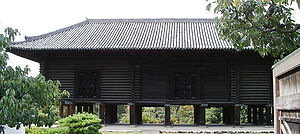Museum
A museum is a building[1] which is open to the public.[2] It is also the institution where things are collected and then shown to people.[3]

History
changeThe word, museum, originates from Musa which is the goddesses of literature, art, and science who appears in Greek mythology.
According to the International Council of Museums (ICOM), the definition of museums has changed over time.[2]
The oldest museum structure in the world is the Shōsō-in in Nara, Japan.[4]
Today's museums are non-profit, permanent institutions in the service of society and its development.[2]
Function
changeA museum acquires, conserves, researches, communicates and exhibits the tangible heritage[5] and the intangible heritage[6] of humanity and the environment.[2]
Museums exist for the purposes of education, study and enjoyment.[2]
Some museums have things that visitors can do. For example, ecomuseums exist.
Museums can be about different things such as art, national history, natural history, or science. People go to museums sometimes to learn, or to simply have fun.
Museums with live animals are called zoos.
Exhibitions
change- Temporary or changing exhibits
- Exhibition which selects works along with some themes, e.g., a writer, a time, an area, etc.
- Permanent exhibits
- Exhibition which displays the works which the museum possesses.
Gallery
changeArt museums
changeHistory museums
change-
The Tōhoku History Museum in Miyagi
Literature museums
change-
Koriyama Museum of Literature in Fukushima is the former home of Masao Kume
Natural history museums
changeOpen air museums
change-
Iwami Ginzan Silver Mine is a World Heritage Site in Shimane Prefecture, Japan
Science museums
change-
Mushitec in Fukushima is about insects
Museum ships
change-
Cutty Sark in London, England
-
Nippon Maru in Yokohama harbor
-
National Museum, Szczecin, Poland
Related pages
changeReferences
change- ↑ Alexander, Edward Porter et al. (2008). Museums in Motion: an Introduction to the History and Functions of Museums, p. 2; excerpt, "Douglas Alan, former director of the Royal Scottish Museum in Edinburgh, said that 'a museum in its simplest form consists of a building to house collections of objects for inspection, study and enjoyment."
- ↑ 2.0 2.1 2.2 2.3 2.4 International Council of Museums (ICOM), "Museum Definition" Archived 2015-03-02 at the Wayback Machine; retrieved 2012-6-26.
- ↑ Alexander, p. 2; excerpt, "The American Association of Museums ... defines 'a museum as an organized and permanent non-profit institution ... which organizes or utilizes tangible objects, cares for them, and exhibits them to the public on some regular schedule."
- ↑ Nussbaum, Louis-Frédéric. (2005). "Museums" in Japan Encyclopedia, pp. 671-672.
- ↑ Miyagi Prefecture, 文化財財案内 (Cultural heritage guide); excerpt, tangible objects include "arts and crafts, ... historical documents, textiles, swords, sculpture, paintings, houses, temples and shrines" Archived 2012-04-21 at the Wayback Machine; retrieved 2012-6-27.
- ↑ Miyagi, 文化財財案内; excerpt, "intangible cultural heritage is 'human technology', such as the process of traditional Japanese sword training, traditional Japanese dyeing and weaving, traditional Japanese theater like Kabuki and Noh" Archived 2012-04-21 at the Wayback Machine; retrieved 2012-6-27.
Further reading
change- Simon, Nina K. (2010). Simon, Nina K. (2010). The Participatory Museum.
Other websites
change- International Council of Museums website
- Virtual Library Musems website Archived 2012-12-12 at the Wayback Machine
- Museum at the Open Directory Project